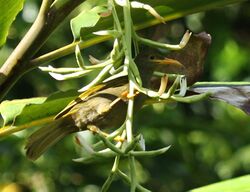Biology:Yellow-billed honeyeater
| Yellow-billed honeyeater | |
|---|---|

| |
| Scientific classification | |
| Domain: | Eukaryota |
| Kingdom: | Animalia |
| Phylum: | Chordata |
| Class: | Aves |
| Order: | Passeriformes |
| Family: | Meliphagidae |
| Genus: | Gymnomyza |
| Species: | G. viridis
|
| Binomial name | |
| Gymnomyza viridis (Layard, 1875)
| |
The yellow-billed honeyeater (Gymnomyza viridis), also known as yodeling giant honeyeater or chattering giant honeyeater, is a species of bird in the family Meliphagidae. It is endemic to Fiji.
Its natural habitats are subtropical or tropical moist lowland forest, and subtropical or tropical moist montane forest. It is threatened by habitat loss.
It occurs on the Vanua Levu and Taveuni islands. It was considered conspecific with the giant honeyeater, although they showed both phenotypic and behavioural differences. A molecular phylogenetic study published in 2014 found that they also differed significantly in their mitochondrial DNA sequences and suggested that G. v. brunneirostris should be promoted to the species level. The International Ornithologists' Union accepted these proposals and introduced the name "yellow-billed honeyeater" for G. viridis and "giant honeyeater" for G. brunneirostris.[2][3]
References
- ↑ BirdLife International (2016). "Gymnomyza viridis". IUCN Red List of Threatened Species 2016: e.T103685849A93962603. doi:10.2305/IUCN.UK.2016-3.RLTS.T103685849A93962603.en. https://www.iucnredlist.org/species/103685849/93962603. Retrieved 11 November 2021.
- ↑ Andersen, M.J.; Naikatini, A.; Moyle, R.C. (2014). "A molecular phylogeny of Pacific honeyeaters (Aves: Meliphagidae) reveals extensive paraphyly and an isolated Polynesian radiation". Molecular Phylogenetics and Evolution 71: 308–315. doi:10.1016/j.ympev.2013.11.014. PMID 24315868.
- ↑ Gill, Frank; Donsker, David, eds. "Honeyeaters". World Bird List Version 6.1. International Ornithologists' Union. http://www.worldbirdnames.org/bow/honeyeaters/.
Wikidata ☰ Q613301 entry
 |


